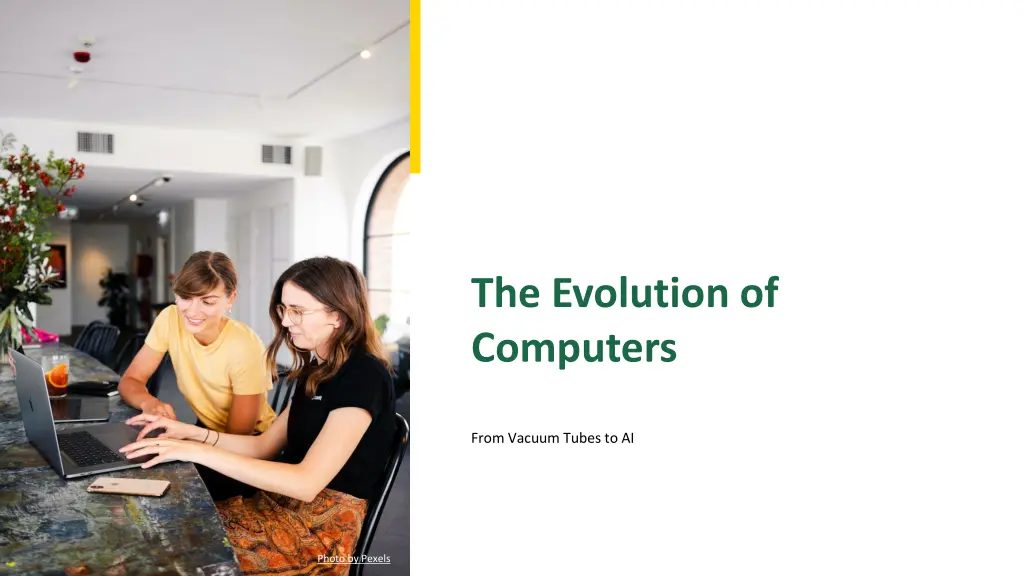
Evolution of Computers: From Vacuum Tubes to AI
Explore the incredible journey of computers from the era of vacuum tubes to the innovation of artificial intelligence. Witness the transformative phases in computing history, from the first-generation colossal machines to the modern-day portable and versatile computers. Discover the impact of advancements like transistors, integrated circuits, microprocessors, and the promising future of AI-powered fifth-generation computers.
Download Presentation

Please find below an Image/Link to download the presentation.
The content on the website is provided AS IS for your information and personal use only. It may not be sold, licensed, or shared on other websites without obtaining consent from the author. If you encounter any issues during the download, it is possible that the publisher has removed the file from their server.
You are allowed to download the files provided on this website for personal or commercial use, subject to the condition that they are used lawfully. All files are the property of their respective owners.
The content on the website is provided AS IS for your information and personal use only. It may not be sold, licensed, or shared on other websites without obtaining consent from the author.
E N D
Presentation Transcript
The Evolution of Computers From Vacuum Tubes to AI Photo by Pexels
01 The Dawn of Computing Table of Contents 02 Transistor Revolution 03 The Integrated Circuit Era 04 Microprocessors Unleashed 05 The Future Awaits 06 A Technological Timeline 07 Key Characteristics 08 Impact on Society 09 Looking to Tomorrow 10 Thank You!
1 The Dawn of Computing First Generation (1945-1956) The first generation emerged using thousands of vacuum tubes, leading to immense power consumption and significant heat generation. These computers were colossal and expensive, requiring machine language for programming using punch cards and paper tapes. Despite limitations, they were the fastest calculators of their era, performing 5,000 additions or 350 multiplications per second. Examples include ENIAC, EDA, and UNIVAC I, shaping the future of computational technology. Photo by Pexels
2 Transistor Revolution Second Generation (1956-1963) Transistors replaced vacuum tubes, reducing size, cost, and enhancing reliabilitywhile increasing processing speed. Energy efficiency improved even as heat generation persisted, marking a significant technological advancement. This generation pioneered magnetic core technology for memory storage, expanding programming languages to machine and assembly languages. Notable models include IBM 7090 and CDC 3600, revolutionizing computing practices. Photo by Pexels
3 The Integrated Circuit Era Third Generation (1964-1971) Integrated circuits (ICs) took center stage, further shrinking computers while boosting speed and affordability. Access to computers became more user-friendly with keyboards and monitors, introducing multitasking operating systems. This accessibility allowed more people to engage with technology, fostering innovation and creativity. Key examples are IBM 360 and PDP 11, instrumental in expanding computer utility. Photo by Pexels
4 Microprocessors Unleashed Fourth Generation (1971-Present) The introduction of microprocessors signified a monumental shift, utilizing VLSI technology to maximize efficiency and performance. Computers became portable with enhanced accuracy, reliability, and larger memory capacities. This era sparked an explosion of GUI applications, changing how users interacted with technology. Today s computers represent this generation, making computing accessible and versatile. Photo by Pexels
5 The Future Awaits Fifth Generation (Future) Fifth generation computers are anticipated to harness artificial intelligence, currently in its nascent phase, paving new frontiers. Utilizing ULSI technology, these computers promise enhanced speed and affordability, coupled with quantum and nano technologies. Emerging intelligent computing systems may redefine how we think, learn, and interact with technology. This evolution hints at a fascinating and promising future, where computing capabilities are boundless. Photo by Pexels
6 A Technological Timeline Generational Overview 1st Generation: Vacuum Tubes (1945-1956) - Large, expensive, slow heat generation. 2nd Generation: Transistors (1956-1963) - Smaller, faster, more reliable, and energyefficient. 3rd Generation: Integrated Circuits (1964-1971) - Compact with operating systems for multitasking. 4th Generation: Microprocessors (1971-Present) - Portable, accurate, advanced GUI and applications. Photo by Pexels
7 Key Characteristics Generational Attributes First Gen: Vacuum tubes, machine language, punch cards. Second Gen: Transistors, magnetic core memory, assembly language. Third Gen: ICs, keyboard access, multitasking OS. Fourth Gen: Microprocessors, VLSI technology, GUI. Photo by Pexels
8 Impact on Society Cultural Transformation Computing advancements have transformed industries, education, and everyday life, increasing productivity exponentially. The evolution of computers has forged new careers, fostering innovation in all fields of society. Accessibility to technology has empowered individuals to achieve unprecedented feats. Computers have shifted societal norms, reshaping communication, entertainment, and learning experiences. Photo by Pexels
9 Looking to Tomorrow Future Perspectives As we stand on the brink of the fifth-generation era, the potential of AI and advanced technology ignites imagination. The synthesis of quantum computing and intelligent systems promises revolutionaryadvancements. Embracing this future enables us to envisage solutions for complex global challenges. Together, we can propel society toward a promising, technologically advanced tomorrow. Photo by Pexels
10 Thank You! Your Attention Matters Thank you for exploring the evolution of computers with us. We hope this journey through time has inspired you to consider the future of technology. Let's embrace the advancements ahead and create a better world together. Photo by Pexels
